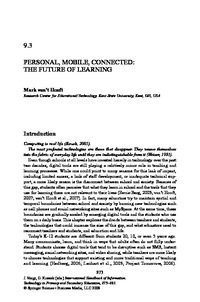Personal, Mobile, Connected: The Future of LearningMark van t Hooft
Zu finden in: International Handbook of Information Technology in Primary and Secondary Education (Seite 873 bis 881), 2009
|
 |
 Diese Seite wurde seit 12 Jahren inhaltlich nicht mehr aktualisiert.
Unter Umständen ist sie nicht mehr aktuell.
Diese Seite wurde seit 12 Jahren inhaltlich nicht mehr aktualisiert.
Unter Umständen ist sie nicht mehr aktuell.
 Zusammenfassungen
Zusammenfassungen
 Digital technologies are increasingly personal, mobile, and connected. Many students use them in their daily lives, but in schools they are regularly limited in what tools they can use and what digital content they have access to. While students want to use digital technologies for learning, educators often ban or limit this use for reasons of safety or learning distractions. This chapter explores the divide between teachers and students, the technologies that could increase the size of this gap, and what educators need to reconnect teachers and students, and education and life. Personal, mobile, and connected technologies should be seriously considered as learning tools, as they can provide the bridge between schools and their surrounding communities, reconnecting the two with learning that is relevant, meaningful, and lifelong.
Digital technologies are increasingly personal, mobile, and connected. Many students use them in their daily lives, but in schools they are regularly limited in what tools they can use and what digital content they have access to. While students want to use digital technologies for learning, educators often ban or limit this use for reasons of safety or learning distractions. This chapter explores the divide between teachers and students, the technologies that could increase the size of this gap, and what educators need to reconnect teachers and students, and education and life. Personal, mobile, and connected technologies should be seriously considered as learning tools, as they can provide the bridge between schools and their surrounding communities, reconnecting the two with learning that is relevant, meaningful, and lifelong. Dieses Kapitel erwähnt ...
Dieses Kapitel erwähnt ...
 Dieses Kapitel erwähnt vermutlich nicht ...
Dieses Kapitel erwähnt vermutlich nicht ... 
 Nicht erwähnte Begriffe | Bildung, Kinder, LehrerIn, Unterricht |
 Tagcloud
Tagcloud
 Anderswo finden
Anderswo finden
 Volltext dieses Dokuments
Volltext dieses Dokuments
 |  Personal, Mobile, Connected: The Future of Learning: Artikel als Volltext bei Springerlink ( Personal, Mobile, Connected: The Future of Learning: Artikel als Volltext bei Springerlink ( : :  , 91 kByte; , 91 kByte;  : :  2020-11-28) 2020-11-28) |
 Anderswo suchen
Anderswo suchen 
 Beat und dieses Kapitel
Beat und dieses Kapitel
Beat hat Dieses Kapitel während seiner Zeit am Institut für Medien und Schule (IMS) ins Biblionetz aufgenommen. Er hat Dieses Kapitel einmalig erfasst und bisher nicht mehr bearbeitet. Beat besitzt kein physisches, aber ein digitales Exemplar. Eine digitale Version ist auf dem Internet verfügbar (s.o.). Aufgrund der wenigen Einträge im Biblionetz scheint er es nicht wirklich gelesen zu haben. Es gibt bisher auch nur wenige Objekte im Biblionetz, die dieses Werk zitieren.









 Lernen
Lernen Schule
Schule
 Biblionetz-History
Biblionetz-History